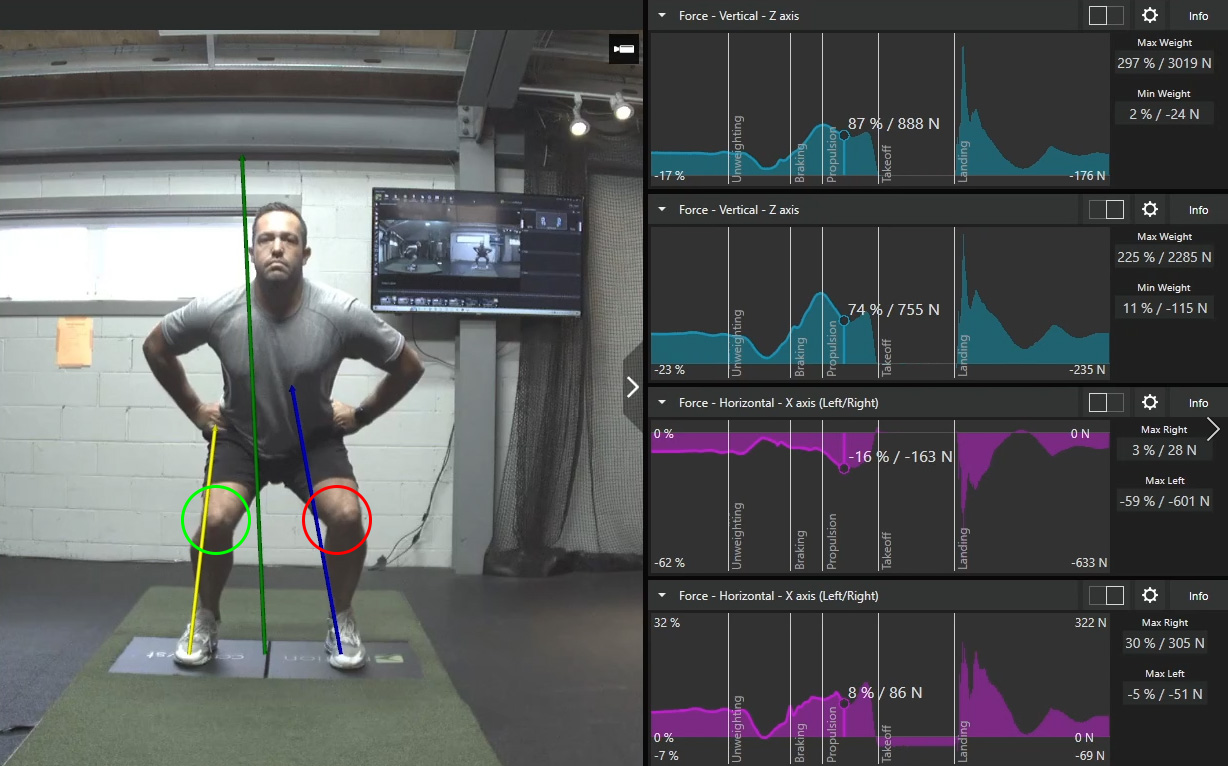Thanks to its unique combination of high-speed video, pressure data and 6 DOF force, the Motion Catalyst system unveils a lot of information which you could not obtain from only looking at vertical forces. One valuable use of this information is identifying injury mechanisms in athletes for injury prevention and rehabilitation.
In the video below, performance specialist Ben Shear and Motion Catalyst Research Director Dr. Scott Lynn analyze a counter-movement jump by our colleague Seath, who has previously injured his left knee.
Analysis
After recording Seath’s counter-movement jump on the 3D Force plate, we can play back the video in slow motion with perfectly synchronized force graphs and force vectors. These tools help us understand how Seath is producing forces during his jump, not just vertically but including shear forces and rotational torques.
One of the first observations we can make from the force vectors is that the blue force vector on his left side is larger than the yellow vector on his right side. This tells us that Seath is creating more force with his left leg, which is his injured leg. We can confirm this by looking at his vertical force graphs, which tell us that he is producing 87% of his body weight on his left leg, and 74% on his right leg.
A second observation is that the yellow force vector on Seath’s right side nearly passes through the center of his right knee joint. When we look at his left side however, the blue force vector passes on the inside of his left knee joint.
The knees are load-bearing joints, so ideally we would like to see both of the force vectors passing close to the center of the joint in this frontal plane view. When the force is directed at a large distance from the joint center, this creates a moment about that joint which can generate shearing force on the joint tissues (in the case to the knee, the ligaments and cartilage/meniscus).
The horizontal force graphs confirm this. You can see that the shearing force is only 8% of Seath’s body weight on his right leg. This is what keeps it aligned close to the joint. On his left leg however, the shearing force is 16% of his body weight. This makes the force vector lean a lot more to the inside, which creates the moment at his knee joint.
What does it mean?
The data tells us that Seath is not protecting his injured leg very well. While many people would put less force on the injured leg to protect it, he is doing the exact opposite. Seath doesn’t mind doing the jump, but because of the way he is doing it he is leaving himself susceptible to further injury.
Knowing this, we would recommend Seath to stay away from jumps for the time being, and instead help him create a system of alignments before we bring him back to this type of activity.
We learnt a lot about Seath through this simple assessment test. Being able to measure vertical, horizontal and rotational ground reaction forces gave us some great insight into Seath’s performance from a health perspective, allowing us to tailor his training to prevent further injury. Had we just been looking at vertical forces we would have missed out on a lot of this information and could easily have ended up recommending training that would make the injury worse.
